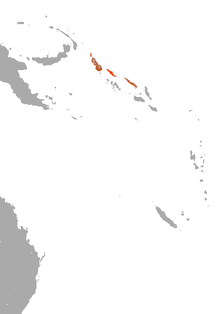Greater monkey-faced bat
| Greater monkey-faced bat | |
|---|---|
| Scientific classification | |
| Kingdom: | Animalia |
| Phylum: | Chordata |
| Class: | Mammalia |
| Order: | Chiroptera |
| Family: | Pteropodidae |
| Genus: | Pteralopex |
| Species: | P. flanneryi |
| Binomial name | |
| Pteralopex flanneryi Helgen 2005 | |
 | |
| Greater monkey-faced bat range | |
The greater monkey-faced bat, (Pteralopex flanneryi) is a megabat endemic to Solomon Islands, Bougainville, in Papua New Guinea, and nearby small islands. It is listed as a critically endangered species and the population is decreasing. It is the largest monkey-faced bat.
"Traditionally, a single species of Pteralopex was thought to occur in the Greater Bukida Islands, Pteralopex anceps, but there are actually two species here. P. anceps is a yellow-bellied, species that, unlike P. flanneryi, prefers upland habitats (Helgen 2005). This species has been recorded from lowland forest from sea level to 200 m on the islands of Bougainville (including the immediately adjacent small island of Puruata), Buka, Choiseul, and Isabel (including the immediately adjacent small island of Barora Fa) (Papua New Guinea and Solomon Islands). These are all land bridge fragments of a formerly larger island. This species appears to be entirely dependent on old-growth, lowland forest. It probably roosts solitarily in foliage, though it might also utilize hollows or cavities of large ficus trees (S. Hamilton pers. comm.). The generation length may be 5 years or a bit longer. Forest clearance and disturbance, along with active hunting, probably threaten this species. Hunting is likely to be a major threat, given the size of this species. Civil tensions in Bougainville from 1987 till 2000 resulted in an increase in hunting pressure."[1]
Footnotes
References
This article is issued from Wikipedia - version of the 5/16/2016. The text is available under the Creative Commons Attribution/Share Alike but additional terms may apply for the media files.
